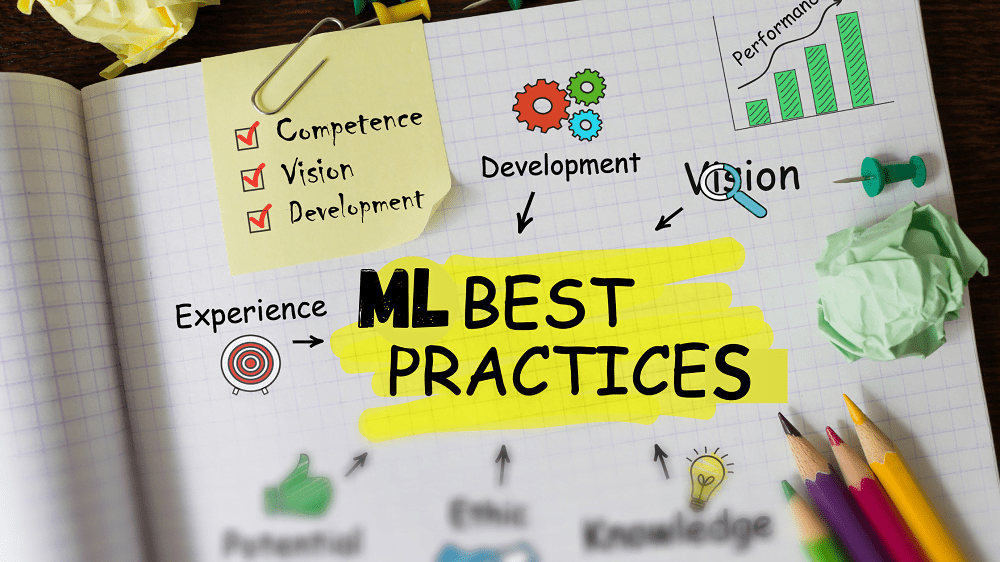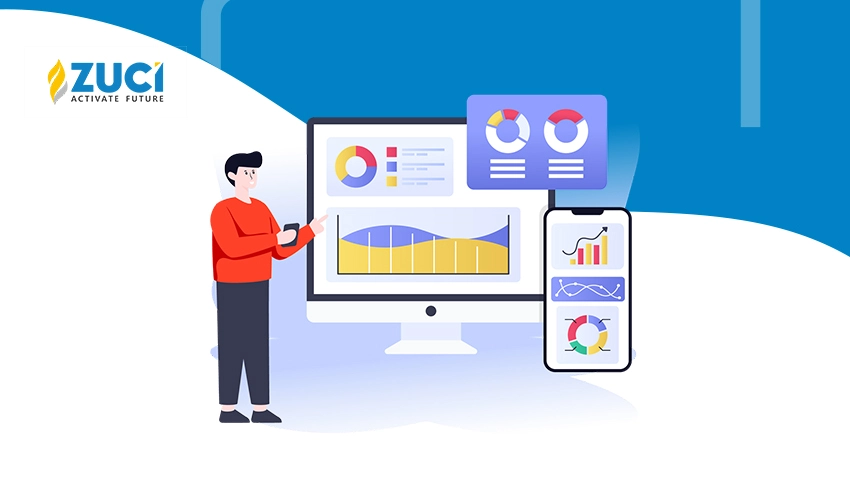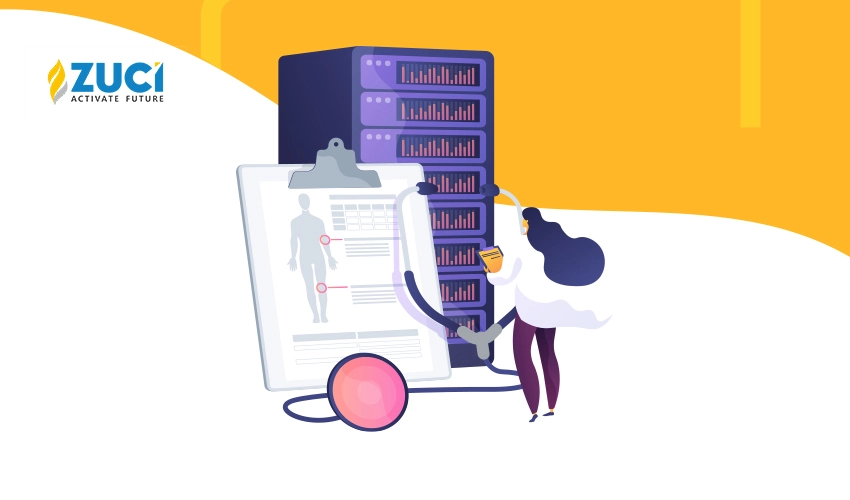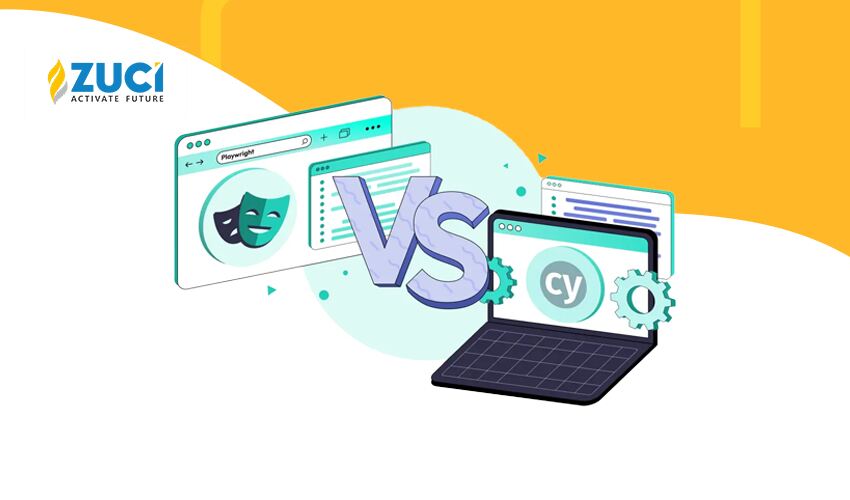Reading Time : 2 Mins
Big Data Analytics & Its Importance in Today’s Business World
I write about fintech, data, and everything around it
It’s a world full of data. From natural to artificial, companies have plenty of data to put to use. The blog explains big data analytics, its importance in today’s world, and how businesses can get started.
With the advent of AI in today’s era, dealing with big data is not only just managing big volumes of stored data. Big data has been buzzing around the corners for quite a good time. Business entities now understand the need for big data and its analysis by acquiring all the data they possess in their business.
In 2016, Starbucks started using AI to engage customers by sending them customized offers. The company used its app and loyalty card to gather customer data and analyze their pattern of purchases, including their choice of drinks. According to a data analysis study, every user on the internet produced 1.7 megabytes of data in just a second in 2020.
Businesses leveraging big data analytics gain value in many approaches, like trimming costs, making informed decisions, and crafting new products. That said, data is important, and big data analytics assist companies like Starbucks in enhancing their data and leveraging it to identify new business opportunities. That, in turn, enables strategic business decisions, more effective operations, and better profitability by keeping clients happy.
On this blog, you will get all the information about big data analytics and its importance in today’s business world. Learn why big data and analytics have taken center stage in the present tech age and how businesses can get started.
Let’s dive right in.

What is Big Data?
Big data is a term used to describe data sets that are too large or complex for standard rotating databases to capture, manage, and process. The database needed to process massive data must have minimal latency, which traditional databases lack. Big data has great variety, high velocity, and high volume.
A single extensive data system may contain text files, XML documents, pictures, raw log files, video, audio, and traditional structured data. This is known as big data diversity and storing and processing some of these data types — mainly enormous photos, video, and audio files — necessitates a system that can scale quickly and rapidly.
What is Big Data Analytics?
Analysis of big data involves the examination of large amounts of data to unzip hidden user patterns, trends, correlations, and other insights. Businesses use big data to harness valuable insights and look for new opportunities. These data sets range in size from terabytes to zettabytes and comprise organized, semi-structured, and unstructured data from various sources.
The process of uncovering the data includes statistical analysis techniques—like clustering and regression. These techniques are further applied to more extensive datasets with new AI tools.
Initially, big data framework Hadoop, Spark, and NoSQL databases played an essential role in storing and processing. Data engineers have found many ways to integrate complex information using machine learning with growing technologies. Analysts, academics, and business users can employ big data analytics to acquire and use previously unavailable and unusable data for faster and more accurate decision-making.
Big data is not only employed to personalize internet experiences. McDonald’s is a fantastic example of this, as they use big data of their user data to personalize their service and cater to them with better offerings. This includes their smartphone application, drive-thru, and digital menus. McDonald’s obtains essential information regarding customer activities through their app.
Types of Big Data Analytics
Several sectors have identified applications for big data analytics. It has enabled companies to know their consumers better, demonstrating the technique’s immense utility. Let’s explore different types of big data analytics techniques.

1. Descriptive Analytics
Organizations use descriptive analytics to remain updated on recent trends and operational performances. It analyses raw data sets by mathematical operations, generating samples and measurements.
After you detect insights with descriptive analytics, you can leverage other analytics to discover more about what leads to those trends. When working with finance, sales, and production, you must leverage descriptive analytics.
Examples of tasks that need descriptive analytics:
- Financial reports
- Survey reports
- Social media initiatives
2. Diagnostic Analytics
Diagnostic analytics provides a comprehensive and exhaustive analysis of a problem. To find the reason behind any specific occurrence, data scientists use analytics. Diagnostic analytics involves drill-down, data mining, and data recovery analysis.
Let’s say there has been an immense variance in a product’s sale even though you have not made any promotional alterations to it. You can use diagnostic analytics to detect this transformation and its cause.
Examples of tasks that need diagnostic analytics:
- Searching for patterns in the data groups
- Filtering of the data sets
- Probability theory
- Regression analysis
3. Predictive Analytics
As the name suggests, this data analytics category enables predictions about future aspects and gives results based on a diverse range of insights from data sets. It leverages predictive tools and precise models like statistical modeling and machine learning for the best outcomes.
Examples of tasks that need predictive analytics:
- Predict the customer’s demands
- Handle shipping schedules
- Remain on top of inventory needs
4. Prescriptive Analytics
Prescriptive analytics takes the outcomes from descriptive and predictive analysis and detects solutions for optimizing business practices. It does this through simulations and advanced analysis techniques. It leverages insights to recommend the best growth steps for an organization.
Google used prescriptive analytics and applied it to designing self-driving cars. These cars analyze data in real time and make decisions based on it.
Examples of tasks that need prescriptive analytics:
- Enhance processes
- Enable campaigns
- Steer production
- Facilitate customer services

15 Data Modeling Tips and Best Practices
Data Modeling is one of the most important parts of information modeling. A good data model, tightly integrated with its applications or systems is easy to understand, maintain and change. In this post, we will discuss top 15 data modeling tips and best practices.
Characteristics of Big Data Analytics
It is necessary to have a deeper understanding of anything vast. These characteristics will aid you in decoding big data and give you a notion of how to deal with massive, fragmented data at a manageable speed in an appropriate amount of time, allowing us to extract value from it and conduct real-time analysis.
By comprehending the attributes of big data, you can gain insight into its use cases and precise applications. Let us explore the critical aspects of big data analytics:
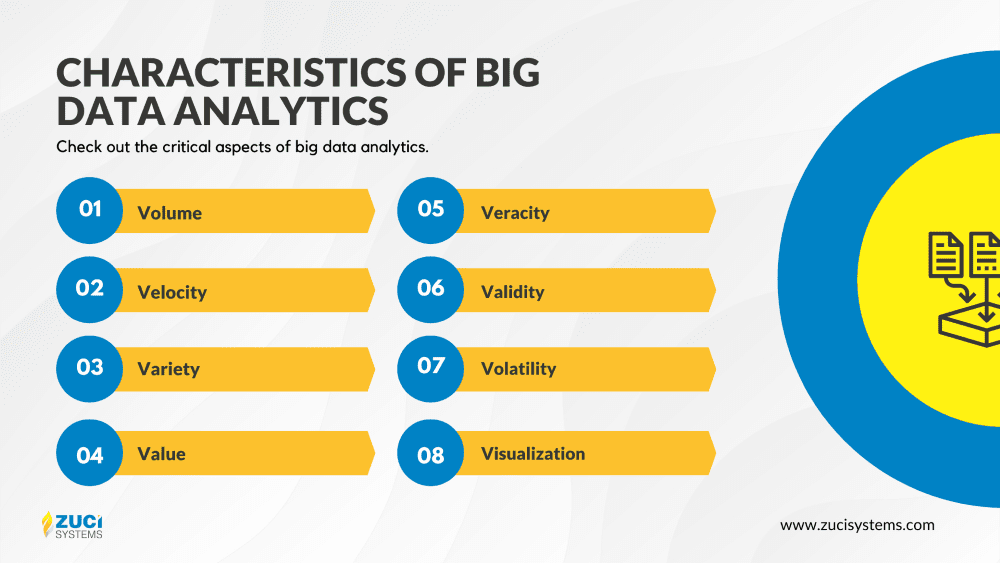
1. Volume
In the current scenario, the amount of data that companies possess matters. For big data analytics, you will need to process higher volumes of structured and unstructured data. This data can be of indefinite value, such as Facebook and Instagram datasets, or data on numerous web or mobile applications. As per the market trends, the volume of data will upsurge considerably in the coming years, and there is a lot of room for extensive data analysis and pattern-finding.
2. Velocity
Velocity refers to the swiftness of data processing. A higher data processing rate is significant for any big data procedure’s real-time evaluation and performance. More data will be accessible in the future, but the processing speed will be equally important for companies to benefit from big data analytics.
3. Variety
Variety refers to the diverse categories of big data. It is among the prime challenges the big data industry faces as it impacts productivity.
With the rising usage of big data, data comes in new data groups. Different data categories, like text, audio, and video, need extra pre-processing to back metadata and derive enhanced value.
4. Value
Value denotes your company’s advantages from the processed and analyzed data. It conveys how data matches your company’s set objectives and does it assist your company in improving itself. It is among the most vital big data core characteristics.
5. Veracity
Veracity denotes the precision of your data. It is essential as low veracity can negatively impact the accuracy of your big data analytics results.
6. Validity
Validity denotes how effective and pertinent the data is to be leveraged by a company for the envisioned objectives and defined purpose.
7. Volatility
Big data is continuously varying. The information you collected from a precise source now might differ in a short time. This scenario indicates data inconsistency and impacts your data accommodation and adaptation rate.
8. Visualization
Visualization or data visualization denotes showcasing your big data-generated analytics and insights through visual illustrations like charts and graphs. It has turned significant as big data experts share their analytics and insights with non-technical addressees.
Big data analytics tools and technology
TechTarget’s Enterprise Strategy Group recently conducted a survey on IT spending parts in the first half of 2022. It was found that many top organizations are using next-generation technology and advancing its use to manage data. Around 97.2% of organizations are investing in Machine Learning and AI.
Big data analytics is a combination of tools used to collect, process, clean, and analyze large amounts of data. Here are some of the essential tools used in the big data ecosystem.

Hadoop
Hadoop is an open-source framework for cost-effectively storing and processing large datasets on commodity hardware clusters. This can manage massive amounts of organized and unstructured data, making it an essential component of any big data project.
The non-relational data management systems, NoSQL databases don’t require a set schema, making them an excellent choice for large amounts of unstructured data. These databases can support a wide range of data models; hence “not simply SQL.”
MapReduce is a vital part of the Hadoop framework that serves two purposes. The initial is mapping, which filters data and distributes it among cluster nodes. The second method, reduction, arranges and condenses the output from each node to reply to a query.
Yarn is a second-generation Hadoop component. Job scheduling and resource management are aided by cluster management technology.
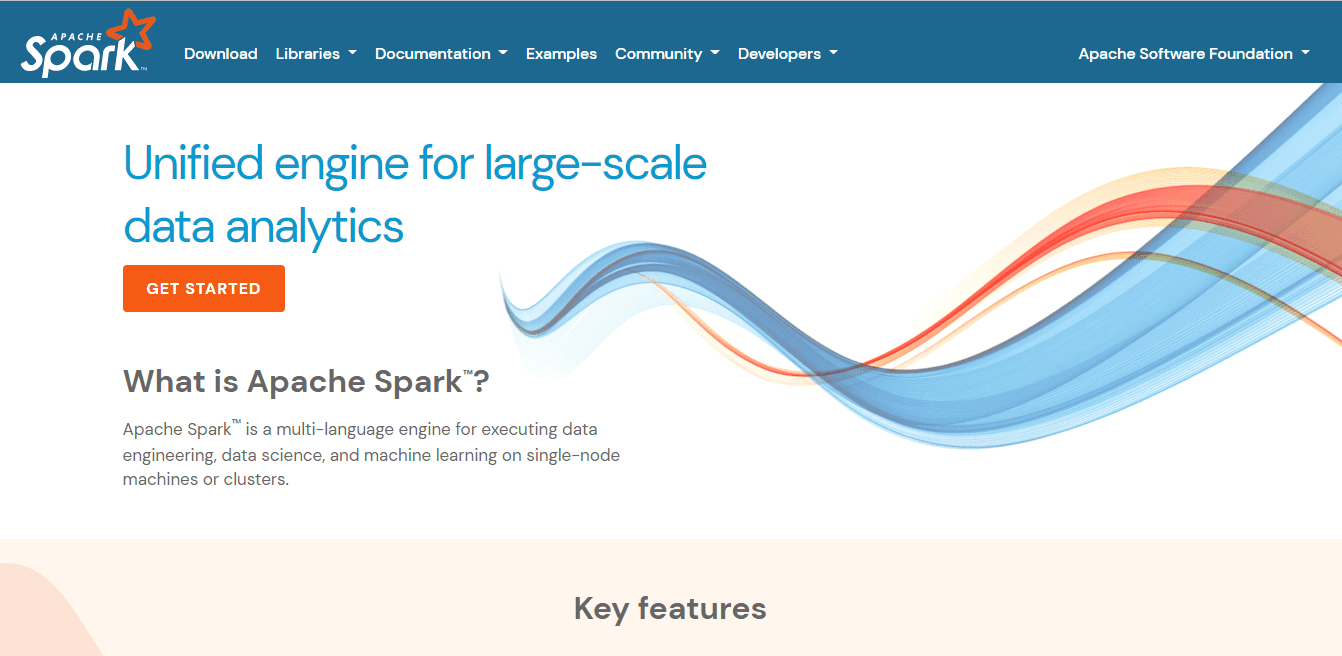
Spark
Spark is a free and open-source cluster computing technology that lets you program entire clusters with implicit data parallelism and fault tolerance. Spark supports batch and stream processing for rapid computations.

Tableau
Tableau is a full-featured data analytics tool. It allows you to create, collaborate, analyze, and share big data insights. It also enables self-service visual analysis, letting users ask questions about the big data being managed and easily share their results across the organization.

RapidMiner
RapidMiner is a precise platform crafted for data analysts who like to blend machine learning and enable predictive model deployment. It is a free, open-source software tool predominantly used for data and text mining.

Microsoft Azure
Microsoft Azure is an explicit public cloud computing platform. It offers a series of services that comprise data analytics, storage, and networking. The tool provides big data cloud offerings in standard and premium versions. It offers an enterprise-scale cluster for the company to operate its big data workloads efficiently.
Benefits of Big Data Analytics to Businesses
Big data analytics has become one of the most sought-after modern technologies due to its features. Let’s explore the benefits of big data analytics and the reasons to consider it for your business.
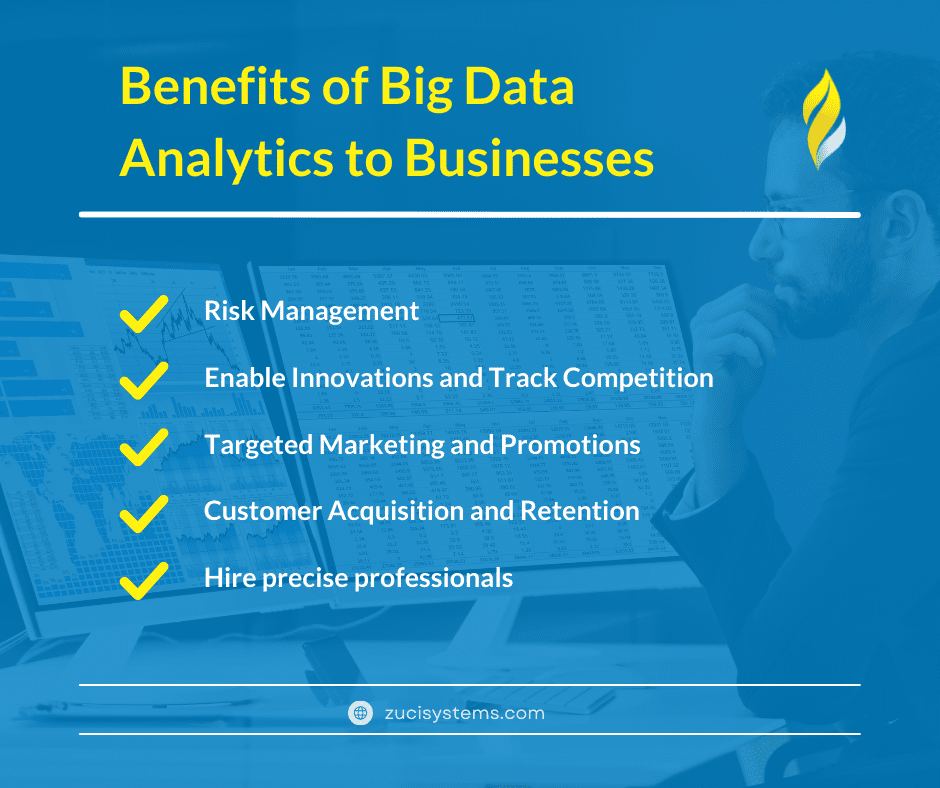
1. Risk Management
A major benefit of big data analytics is risk management. It provides critical insights into consumer behavior and market trends that assist organizations in evaluating their position and advancement.
2. Enable Innovations and Track Competition
The insights you receive leveraging big data analytics are significant for driving innovations. Big data enables you to improve present products and services while innovating new offerings.
The large volume of data gathered assists businesses detect what fits their client base. Insights on what others think of your products and services can aid product development.
The insights can also be utilized to shape business strategies, enhance marketing techniques, improve staff productivity, track customer reviews and optimize client services.
Big data analytics offers real-time marketplace monitoring and keeps you ahead of the competition.
3. Targeted Marketing and Promotions
Big data enables businesses to offer personalized products to their targeted marketplace. It saves from investing in generic marketing and promotional campaigns that do not deliver expected results.
Big data allows companies to analyze client trends by tracking digital shopping and point-of-sale transactions. The insights generated are then leveraged to develop targeted marketing campaigns that assist businesses in meeting client expectations and creating customer loyalty.
4. Customer Acquisition and Retention
The online footprints of customers tell a lot about their requirements, likes, preferences, buying behavior, and more. Companies leverage big data and analytics to observe these consumer patterns and customize their products according to precise customer demands. This goes a long way in ensuring client contentment and loyalty and brings an increase in sales.
5. Big data assures that you hire the precise professionals
Big data analytics are now commonly leveraged by companies even in the hiring and recruitment processes. And they can be advantageous to job seekers and employers. Now, companies of any size and type can use diverse data analytics they might not have even comprehended as valuable in the past to gain competitive benefits in the labor market.
Companies who use their internal engagement statistics, staff profiles, and work-related data in the job marketplace can more effortlessly source and maintain the right talent for their business operations.
Further, data analytics may assist companies in finding better-fitting recruits and even meeting workplace benchmarks, which leads to improvements in the engagement levels of employees.
The working of big data analytics
A company leveraging big data should create well-defined steps for the development, implementation, and operation of analytics.
The processing steps for converting data sets into decisions are listed below:

Step 1: Define the business challenges and goals
As a foremost step, a detailed definition of the business challenges to be anticipated is required. The goals and objectives of applying analytics need to be defined. Some examples include:
- Customer segmentation of a financial portfolio
- Fraud detection for debit or credit cards.
- A telco’s retention modeling for a postpaid subscription
Step 2: Identify relevant data sources
The subsequent step is to identify data that could be potentially worthy. The more the data and information, the better the analysis! The analytical model will later decide which data sets are applicable for the activities. The collected data is then amalgamated in a staging space like a data mart or data warehouse. Exploratory data analysis can then be enabled here with OLAP facilities for a precise roll-up, drill down, slicing, and dicing.
Step 3: Select the data modeling for your business problem
This step will predict an analytical model on the preprocessed, altered, and transformed data sets. By relying on the business objective and the explicit activity at hand, a specific analytical technique will be chosen and enabled by the data scientist.
Step 4: Verify and validate the outcomes from the data modeling
Finally, once the outcomes are accessible, they will be measured by the business specialists. Outcomes may be rules, clusters, or patterns. Trivial patterns that the analytical model may identify will assist in verifying and validating the model.
Step 5: Validate, deploy, and integrate with necessary systems
Once the analytical model has been precisely verified and approved, it can be placed right into production as a precise analytics application like a scoring engine. Here it would help if you showcased the model output in a friendly approach, integrated it with applications like marketing campaign management tools, and ensured the analytical model can be tracked and back-tested continuously.
Working with Big Data on Cloud
Business entities manage their big data on the cloud. The value of data and its use is being recognized by companies now. Big data is now being used to train models and aid AI with Machine Learning.
In many cases, it’s as simple as creating a storage account, naming the data lake, and acquiring the connection string and credentials necessary to connect to the data lake. The majority of cloud service providers have straightforward solutions for this.
- A hybrid cloud architecture lets you build your data lake by incorporating cloud and on-premises technology.
- Zones for the data lake should be created. However, data lakes aren’t just masses of unstructured information in the real world. To better serve diverse user groups, breaking them up into zones is a good idea to serve various user groups better.
- Data is ingested into the data lake in a raw form, called the landing zone, which also goes by the name “ingestion zone.”
- The second zone is the production zone after cleaning, conforming, and preparing data for use. This one is the closest if you’re looking for something similar to a data warehouse.
- Developers and data scientists commonly have access to a “sandbox,” or working area, where they can keep temporary files and data structures.
- To guarantee that critical data sets are protected, a private or sensitive data zone with limited access may be necessary for some industries.
- The data assets need to be cataloged and organized. A comprehensive list of data resources is essential in an extensive data system because of the wide variety of data stored there.
- For example, a cloud platform provider may provide its classification and search system. Data catalogs that cater to the specific demands of data scientists, business users, and developers can be beneficial in many cases.
However, training is required due to the differences between the big data environment and standard database and data warehouse technologies. Other security and data governance requirements, such as user rights and permissions, must also be considered. This is when the journey into the world of big data begins.
Nonetheless, big data’s economic gains and advantages are well worth the time and effort. If you don’t have access to big data, you won’t be able to make smart, long-term changes and gain an advantage over your competition.
Conclusion
Data analytics has transformed the decision-making approach of businesses. The significance and use of big data analytics are upsurging exponentially. It is steering enhancements in the domains it is currently utilized. It will also lead to critical technology and industrial development in the future.
So, whether you are an SME or enterprise company, data tracking is the key to the success of your business. Schedule a 30-minute call and learn about Zuci’s Data Engineering Services to craft a single source of truth system for real-time data analytics, business reporting, optimization, and analysis.
Related Posts





